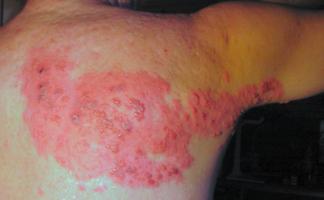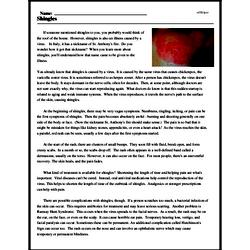Shingles
If someone mentioned shingles to you, you probably would think of the roof of the house. However, shingles is also an illness caused by a virus. In Italy, it has a nickname of St. Anthony's fire. Do you wonder how it got that nickname? When you learn more about shingles, you'll understand how that name came to be given to the illness.
You already know that shingles is caused by a virus. It is caused by the same virus that causes chickenpox, the varicella zoster virus. It is sometimes referred to as herpes zoster. After a person has chickenpox, the virus doesn't leave the body. It stays dormant in the nerve cells, often for decades. Then, at some point, although doctors are not sure exactly why, the virus can start reproducing again. What doctors do know is that this sudden startup is related to aging and weak immune systems. When the virus reproduces, it travels the nerve's path to the surface of the skin, causing shingles.
At the beginning of shingles, there may be very vague symptoms. Numbness, tingling, itching, or pain can be the first symptoms of shingles. Then the pain becomes absolutely awful - burning and shooting generally on one side of the body or face. (Now the nickname St. Anthony's fire should make sense.) The pain is so bad that it might be mistaken for things like kidney stones, appendicitis, or even a heart attack! As the virus reaches the skin, a painful, red rash can be seen, usually a few days after the first symptoms started.




